|
|
 |
| COUCHING / DRYING / DOCHIM |
 |
Couching
Couching requires an incredible amount of experience and skill.
This is because there is no guide to align the Bal on the post.
After couching, some papermakers roll a wooden log, Geung Gul Dae,
across the back of the Bal from side to side. Such rolling eliminates
any bubble on the wet sheet and speeds the drainage. At this point,
the Bal is removed from one end to the other as if being peeled.
One string is put between each paper in order to separate the
individual sheets later. This string is called Bae Gae.
In case of We Bal papers, which has Yin and
Yang layer in one sheet,
string is put between every two layers. The post of
wet paper is drained overnight before being pressed.
|
|
| |

No guides are used to align sheets
|
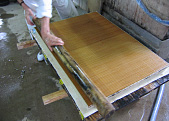
Rolling a log across the Bal
|
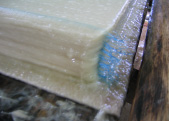
String separates each sheet
|
|
|
 |
|
Drying
The last step in papermaking is drying. Today,
most papermakers use heated stainless steel panels,
but traditional method is air drying on wood board.
When paper is air dried on wood board, it takes
about half a day during the winter, and approximately one hour
on a sunny summer day. It maintains similar texture
on both sides and the distinct properties of Hanji,
subtle sheen and softness, can be best experienced.
On the other hand, papers dried on heated stainless
steel has one smoother side, which can be useful for certain projects.
Another interesting Korean tradition is drying
on heated floor, Ondol.
A room designated for the purpose of drying
Hanji is called
Ji Bang, translated
to 'paper room'.
|
|
| |
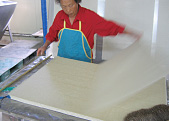
Separating each wet sheet
|
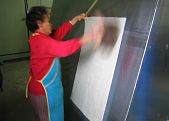
Heat drying on stainless steel
|
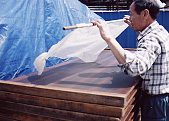
Air drying Hanji on wood board
|
|
|
| |
 |
 |
|
Dochim (Manual calendering)
Some Hanji
are treated with an extra finishing process called Dochim.
This special surface treatment is similar to manual
calendering or burnishing in western papermaking. About one hundred
sheets are treated at a time. One wet sheet is inserted
between every ten dry sheets. This stack is pressed with
a board on top for moisture to be evenly distributed.
Once the stack is moistened, it is pounded two to three
hundred times. Afterwards, the damp sheets are shuffled
to control not only the moisture, but also the amount of
beating on the paper surface.
After this process is repeated several times, the
fiber becomes compact, making Hanji surface smooth and
without fuzz. Dochim also adds strength and a beautiful
sheen. It is an extra step for highest quality Hanji and
requires an amazing amount of care, physical effort, and
most importantly, intuition.
|
|
| |

Before Dochim
|
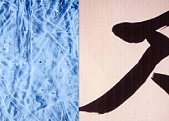
After Dochim: less ink bleed
|
|
|
|

